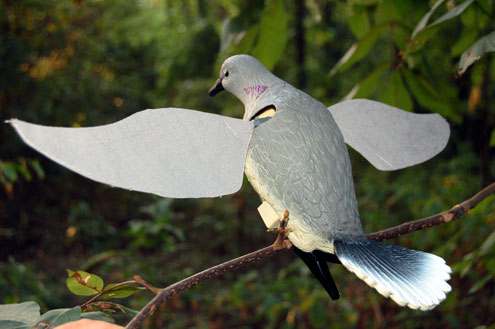
I guess, as a young dove shooter, I did very little hunting. I simply positioned myself on a pond dam or along a tree line bordering a grain field and banged away at passing doves. Truthfully, I sometime harvested dove and sometime wished there were dove to harvest! I had left hunting out of the equation!
Granted, dove often arenít hunted in the same manner as many other game birds and animals but they should be! Take goose hunting for instance. Iíve enjoyed many successful goose hunts from the Canadian border to the Texas coast and every hunt had one common denominator: preparation. Scouting occurred the day before the hunts and decoys and calls were used to attract the birds within shotgun range. Iíve never tried using dove calls to bring passing birds in close but I know for a fact that proper scouting is important to locate concentrations of birds and a mixture of stationary and spinning-wing decoys will bring the birds in close for the shot.
Here are a few things that Iíve learned about dove hunting from almost a half-century in the dove fields each fall. I bet if youíve spend very much time pursuing this great game bird; you can add a few of your own tips to my list!
SCOUT FIRST - Most of us are limited to the fields we can hunt. Individual fields may not be Ďred hotí on any given hunt but scouting before the hunt will insure you set up where your percentages are best. From a good vantage point, use binoculars during early morning and late afternoon and determine the flight pattern used by doves.
Then, locate a good spot to ambush them. The end of tree lines, grown up fence rows or even high weeds adjacent a grain field can be good spots to hunt. If youíre hunting over a pond, chances are pretty good that dove have a particular area they prefer to come to water. These Ďwatering zonesí usually are areas with clean banks that provide grit for the birds and protection from predators. Also, pay attention to the wind when choosing a spot to hunt. All birds take off and land into the wind.
CROSSING SHOTS ARE MOST DIFFICULT - For most hunter, crossing shots at dove are the most difficult to make, especially shots on fast flying birds. Itís very common to shoot behind birds flying right to left or left to right. Nothing sharpens the eye for these shots better than a few rounds of skeet or trap. Practice by beginning your shotgun swing behind the flying bird (clay target), seeing daylight behind your shotgun barrel and the flying bird and pulling the trigger. The trick for the shotgunner is just how much daylight is required in order to put the shot string at the exact spot where the bird will be! This study in physics has challenged the wingshooter since the invention of black powder and shot; itís also what makes dove hunting so much fun. To my way of thinking, dove are the most challenging of all birds to knock down with a scattergun.
BLEND INTO YOUR SOURROUNDINGS - Back in the early sixties when I first began hunting dove, blue jeans and a dark colored T shirt was the uniform of the day. Dove have excellent eyesight and from their elevated position, they can easily spot anything that looks out of the ordinary, ie, hunters) wearing solid colors. These days, I hunt dove in the same light weight, breathable camo I use for early season bow hunting. Wear camo and avoid movement until you begin your shotgun swing and changes are very good that you will have a heavier game bag at the end of your shoot!
RETRIEVE YOUR BIRDS IMMEDIATELY - Dove blend well into their surroundings and many are lost by hunters that take they eye off a falling bird and shoot at another. Unless shooting over a recently cut grain field or area with short grass, Itís a good idea to watch your bird hit the ground afer the shot and go immediately to retrieve it, especially if youíre not hunting with a good retriever.
USE DECOYS - Ten years ago, decoys were seldom used by dove hunters but weíve caught on to the fact that doves are flocking birds and they respond well to decoys. Motion type decoys (spinning and flapping wing) have proved to be highly effective. My current decoy spread includes three stationary decoys and a couple of Ďflapping wingí decoys by Edge by Expedite www.edgebyexpedite.com.

These decoys run on 3 AAA batteries and with removable wings, are easy to transport into and out of the field. On many occasions, Iíve had dove actually fluttering overhead above the flapping wing decoys. They work and I use them on every hunt.
OUTDOOR TIP OF THE WEEK: With the opener of dove season at hand, many of us will be looking forward to eating the rewards of our hunts. The key to tasty dove is keeping the birds cool while in the field. I bring an ice cooler and carry gallon freezer bags for this purpose.
While on a white wing hunt in Mexico, I learned a great recipe for dove breasts. Use a thin-blade fillet knife and take the time to remove the breast meat from each side of the dove breast.
Place a sliver of jalapeno on the piece of boneless breast meat and wrap with bacon. Place over hot coals and baste frequently with your favorite syrup. The blend of flavors created by the jalapeno and syrup will have your guests coming back for more. LC
Listen to Outdoors With Luke Clayton Radio at www.catfishradio.com. Contact Luke with outdoor news from your area at lukeclayton@prodigy.net